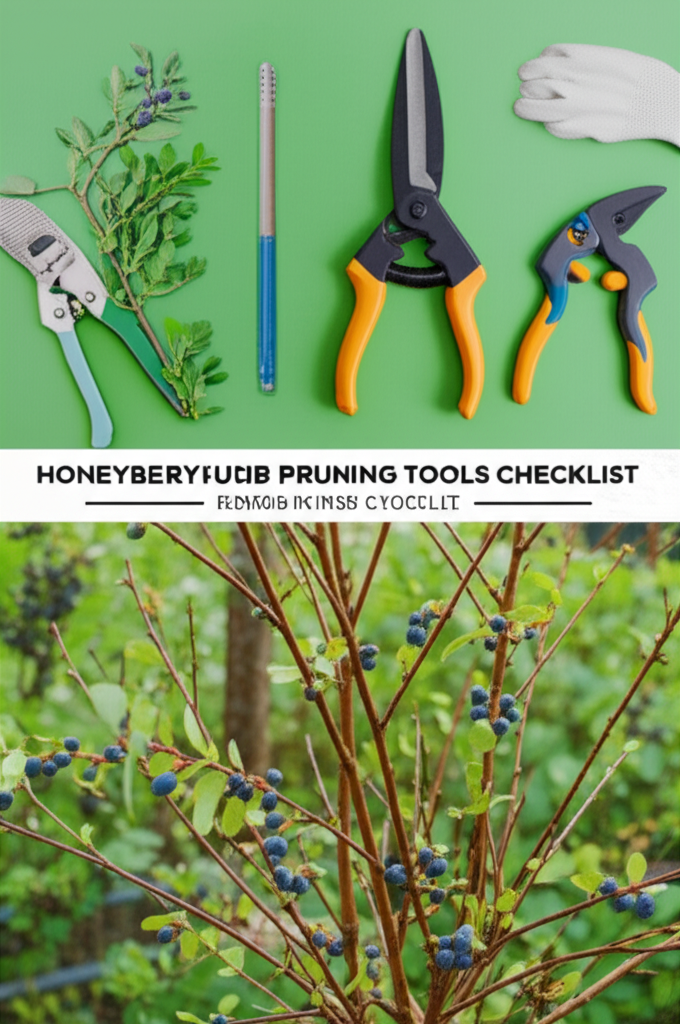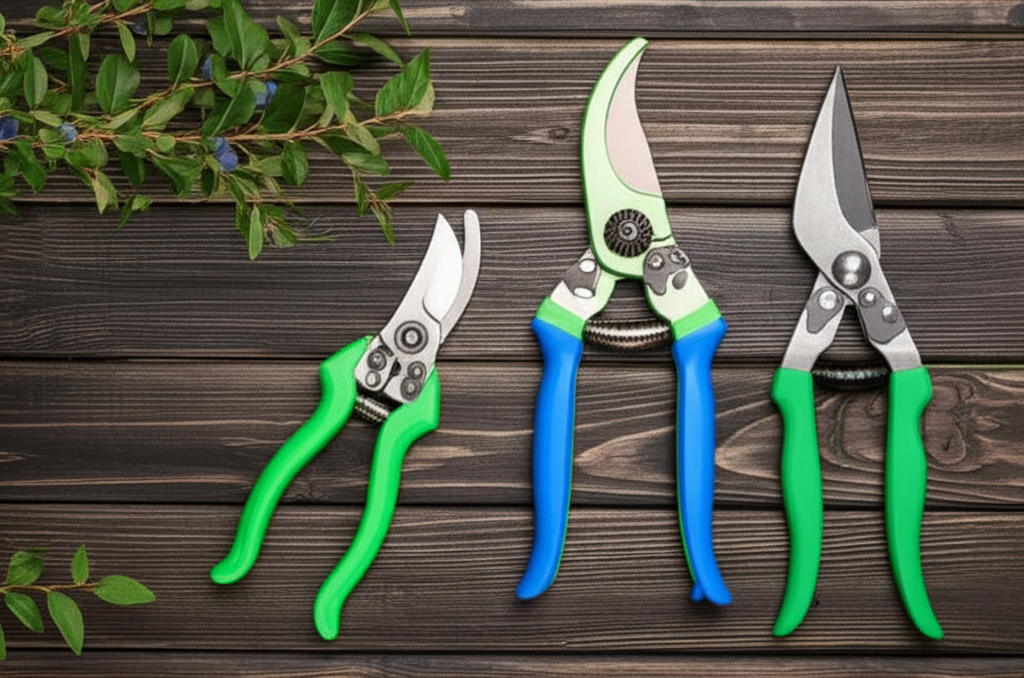Understanding Honeyberry Pruning
Honeyberry (also known as Haskap) shrubs are increasingly popular for their delicious, antioxidant-rich berries and their resilience. To ensure a healthy, productive, and aesthetically pleasing shrub, regular pruning is essential. Pruning not only removes dead or diseased wood but also promotes better air circulation, encourages new growth, and can even influence berry size and yield. However, effective pruning relies on having the right tools for the job. Using dull or inappropriate tools can damage the plant, invite disease, and make the pruning process more difficult and less rewarding. This guide provides a comprehensive checklist of the essential tools you’ll need to prune your honeyberry shrub with confidence and precision.
Why Pruning Honeyberries is Important
Before diving into the tools, it’s crucial to understand why we prune honeyberries. These shrubs benefit from pruning for several key reasons:
- Disease and Pest Prevention: Removing damaged, diseased, or crossing branches helps prevent the spread of pathogens and pests.
- Improved Air Circulation: Thinning out the interior of the shrub allows for better airflow, reducing the risk of fungal diseases.
- Increased Berry Production: Pruning encourages the growth of new, more productive fruiting wood.
- Shaping and Size Control: Keeping the shrub within a manageable size and shape makes harvesting easier and improves its visual appeal.
- Stimulating Vigorous Growth: Removing older, less productive branches stimulates the plant to produce new, stronger shoots.
Essential Pruning Tools for Honeyberry Shrubs

Having the right tools readily available can make the difference between a successful pruning session and a frustrating one. Here’s a breakdown of the must-have equipment.
Hand Pruners (Secateurs)
Hand pruners are the workhorse of pruning. For honeyberries, you’ll likely need two types:
Bypass Pruners
These are the most common and versatile type of pruner. They feature two curved blades that slide past each other, much like scissors.
- Best for: Cutting live wood up to 3/4 inch in diameter.
- Why they’re essential: The clean cut made by bypass pruners is crucial for the health of honeyberry plants, minimizing damage and promoting quick healing.
- Key features to look for: Ergonomic handles for comfort, sharp, high-carbon steel blades for durability and clean cuts, and a locking mechanism to keep them closed when not in use.
Anvil Pruners (Optional, for specific tasks)
Anvil pruners have one sharp blade that closes onto a flat surface (the anvil).
- Best for: Cutting dead or dry wood.
- Why they might be useful: While bypass pruners are generally preferred for live wood, anvil pruners can be effective for tackling tougher, dead branches. However, they can crush live stems, so use with caution.
Loppers
When branches become too thick for hand pruners, loppers are the next step up. They have longer handles, providing greater leverage and allowing you to cut branches up to 1.5 to 2 inches in diameter, depending on the model.
- Best for: Thicker branches that bypass pruners can’t handle.
- Why they’re essential: They extend your reach and provide the necessary force to cut through thicker woody stems cleanly, preventing frustration and damage to the plant.
- Key features to look for: Bypass blades are preferred for live wood, lightweight but strong handles (fiberglass or aluminum), and comfortable grips.
Pruning Saw
For branches that are too thick even for loppers (typically over 2 inches in diameter), a pruning saw is indispensable.
- Best for: Branches thicker than 2 inches.
- Why they’re essential: Trying to force loppers or hand pruners on branches that are too large will damage the tools and the plant. A good pruning saw makes these larger cuts efficiently and cleanly.
- Types to consider:
- Folding Saws: Compact and safe to store.
- Straight-Bladed Saws: Offer good control.
- Curved-Bladed Saws: Can be easier to use in tight spaces and often cut faster.
- Key features to look for: Sharp, hardened steel teeth that are impulse-hardened for longevity, a comfortable and secure handle, and a blade designed for efficient wood cutting.
Hedge Shears (Optional, for shaping hedges but less ideal for individual branch cuts)
While not strictly necessary for pruning individual honeyberry branches for health and production, hedge shears can be useful if you’re maintaining a formal hedgerow of honeyberries.
- Best for: Trimming and shaping hedges.
- Why they might be useful: For creating a uniform hedge line.
- Caution: For specific branch removal, hand pruners or loppers are far superior as they allow for precise cuts that heal better. Using hedge shears on larger, individual branches can result in ragged cuts and damage.
Other Useful Accessories
Beyond the cutting tools, a few other items will enhance your pruning experience and ensure the health of your honeyberry shrubs.
Sharpening Stone or File
Dull blades are the enemy of healthy plants and efficient pruning. Regularly sharpening your tools is paramount.
- Best for: Maintaining sharp edges on your pruners, loppers, and saws.
- Why they’re essential: Sharp tools make clean cuts, which heal faster and are less susceptible to disease. Dull tools crush wood, leaving ragged wounds that are entry points for pathogens.
- Types: Diamond files, whetstones, or specialized sharpening stones designed for garden tools.
Tool Cleaning Wipes or Alcohol Spray
Sanitation is key, especially if you are pruning multiple plants or have observed any signs of disease.
- Best for: Cleaning blades between cuts, especially when moving between plants or after cutting diseased wood.
- Why they’re essential: Prevents the spread of diseases like fungal infections or bacterial blight from one plant to another, or even from one branch to another.
- Options: Isopropyl alcohol (70% or higher) in a spray bottle or pre-moistened disinfecting wipes specifically for garden tools.
Gloves
Protecting your hands is important for comfort and safety.
- Best for: Protecting hands from thorns (though honeyberries are generally thornless, some varieties can have minor prickles), sap, and general cuts or abrasions.
- Why they’re essential: Garden gloves provide grip, prevent blisters, and protect your skin.
- Key features to look for: Durable material like leather or reinforced synthetic fabrics, a good fit, and adequate dexterity.
Safety Glasses
When cutting branches, especially thicker ones or those under tension, small pieces of wood or sap can fly.
- Best for: Protecting your eyes from flying debris.
- Why they’re essential: Eye injuries can be severe. Safety glasses are a small but critical piece of safety equipment.
Gardening Tarp or Sheet
To collect pruned material easily.
- Best for: Collecting pruned branches and debris for disposal.
- Why they’re useful: Makes cleanup much faster and prevents small debris from scattering into the lawn or garden beds.
Key Facts and Comparison of Pruning Tools
To help you make informed decisions about your pruning toolkit, here’s a quick reference table.
| Tool | Primary Use | Maximum Cutting Diameter (Approximate) | Key Benefit | When to Use |
|---|---|---|---|---|
| Bypass Hand Pruners | Cutting live wood | 3/4 inch | Clean cuts, promotes healing | Thinning small branches, removing suckers |
| Loppers | Cutting thicker live wood | 1.5 – 2 inches | Increased leverage for larger branches | Removing secondary branches, thicker stems |
| Pruning Saw | Cutting very thick wood | 2+ inches | Handles branches too large for pruners/loppers | Removing old, large structural branches |
| Anvil Pruners | Cutting dead wood | 3/4 inch | Effective on dry, brittle wood | Removing dead or dying branches |
Pruning Steps and Tool Considerations
Here’s a general process for pruning honeyberries, highlighting which tool to use at each stage and the pros and cons of proper tool maintenance.
Steps for Honeyberry Pruning
Table 2: Honeyberry Pruning Steps & Tool Usage
| Step | Action | Recommended Tool(s) | Why |
|---|---|---|---|
| 1 | Initial Assessment & Cleanup Remove dead, diseased, or damaged branches. |
Bypass Hand Pruners, Loppers, Pruning Saw (for larger deadwood) | Prevents disease spread, clears the way for further pruning. Use sterile tools. |
| 2 | Remove Crossing/Rubbing Branches Identify branches that rub against each other. |
Bypass Hand Pruners | Prevents wounds and potential disease entry points caused by friction. |
| 3 | Open Up the Center Thin out inward-growing branches or crowded areas to improve air circulation. |
Bypass Hand Pruners, Loppers | Reduces humidity within the canopy, lowering disease risk. |
| 4 | Remove Weak or Spindly Growth Eliminate thin, unproductive shoots that are unlikely to produce good fruit. |
Bypass Hand Pruners | Directs the plant’s energy into stronger growth. |
| 5 | Head Back Overgrown Branches (Optional) Shorten long branches to encourage bushier growth or manage size. |
Bypass Hand Pruners, Loppers | Helps maintain shape and encourages branching. Cut just above an outward-facing bud. |
| 6 | Remove Oldest Canes (Age 5+ Years) Honeyberries fruit best on wood that is 2-4 years old. Remove the oldest, least productive canes at the base. |
Loppers, Pruning Saw | Stimulates new basal growth which will become the next generation of fruiting wood. |
| 7 | Clean Up Gather all pruned material. |
Gardening Tarp, Gloves | Prevents debris from harboring pests or diseases. |
Pros and Cons of Tool Maintenance
Properly maintained tools offer significant advantages. Neglecting them leads to a host of problems.
| Aspect | Pros of Well-Maintained Tools | Cons of Poorly-Maintained Tools |
|---|---|---|
| Cutting Ability | Sharp blades make clean, precise cuts that heal quickly and minimize sap loss. | Dull blades crush plant tissue, creating ragged wounds that are prone to disease and take longer to heal. |
| Plant Health | Reduced stress on the plant, lower risk of disease transmission. | Increased stress, higher susceptibility to pathogens and pests entering through damaged tissue. |
| User Effort | Easier to use, less physical strain, more enjoyable experience. | Requires excessive force, leading to hand fatigue, blisters, and potential injury. |
| Tool Longevity | Tools last longer and perform optimally. | Blades dull faster, handles can break, mechanisms seize, requiring premature replacement. |
| Efficiency | Faster and more effective pruning. | Slower, less efficient, and more time-consuming. |
Choosing Quality Tools
Investing in quality pruning tools is an investment in your garden’s health and your own enjoyment. Look for brands known for durability and performance. Consider the following when purchasing:
- Material: High-carbon steel blades are generally preferred for their ability to hold a sharp edge and their durability. For handles, fiberglass or aluminum offer a good balance of strength and lightness.
- Ergonomics: Tools that fit comfortably in your hand will reduce fatigue and improve control. Many modern tools feature cushioned or contoured grips.
- Bypass vs. Anvil: As discussed, bypass is almost always the best choice for live wood.
- Reputation: Research reputable brands known for their garden tools.
- Sharpening Compatibility: Ensure the tools can be easily sharpened with standard sharpening stones or files.
Conclusion
Equipping yourself with the right tools is the first step towards successful honeyberry pruning. From sharp bypass pruners for delicate cuts to robust loppers and saws for thicker growth, each tool plays a vital role. Don’t forget the essential accessories like sharpening stones and cleaning supplies that ensure both the health of your plants and the longevity of your tools. By using the appropriate tools and maintaining them well, you’ll make pruning a more efficient, enjoyable, and ultimately, more rewarding task, leading to healthier, more productive honeyberry shrubs for years to come.


